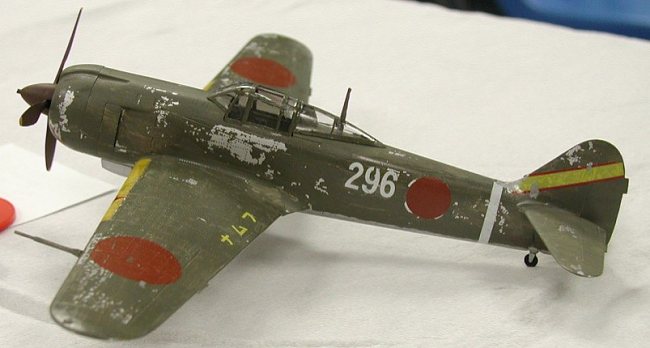
|
KIT # |
|
|
PRICE: |
$5.00 (swap meet) |
|
DECALS: |
Three Aircraft |
|
REVIEWER: |
Rick Craybill |
| PHOTOS: | Tom Dunbar |
|
NOTES: |
|

|
HISTORY |
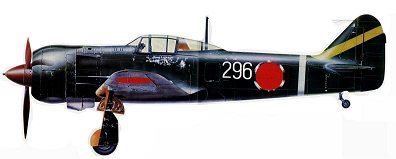 The Kawasaki Ki.100 was a
late-war adaptation of the Ki.61 Tony airframe to take the Mitsubishi Ha-112
14-cylinder radial after supplies of the Kawasaki Ha-140 12-cylinder ‘Vee” type
engine ran low. The engine cowling/exhaust stack layout was derived from a
Focke-Wulf FW 190 tested by the Japanese. Initial testing revealed a substantial
increase in handling qualities and serviceability compared to the Ki.61, and the
aircraft was placed in production after only 100 days. It was considered the
best IJAAF fighter of the war. In everything but level speed, the Ki.100 was a
match for any American fighter, including the P-51 Mustang. Original conversions
had a razorback fuselage, but the model II had a cut-down rear fuselage and
all-around canopy. Japanese Home Defense squadrons such as the 59th
and 244th Sentai extensively used the Ki.100. Only one example in a
British aviation museum is known to exist today.
The Kawasaki Ki.100 was a
late-war adaptation of the Ki.61 Tony airframe to take the Mitsubishi Ha-112
14-cylinder radial after supplies of the Kawasaki Ha-140 12-cylinder ‘Vee” type
engine ran low. The engine cowling/exhaust stack layout was derived from a
Focke-Wulf FW 190 tested by the Japanese. Initial testing revealed a substantial
increase in handling qualities and serviceability compared to the Ki.61, and the
aircraft was placed in production after only 100 days. It was considered the
best IJAAF fighter of the war. In everything but level speed, the Ki.100 was a
match for any American fighter, including the P-51 Mustang. Original conversions
had a razorback fuselage, but the model II had a cut-down rear fuselage and
all-around canopy. Japanese Home Defense squadrons such as the 59th
and 244th Sentai extensively used the Ki.100. Only one example in a
British aviation museum is known to exist today.
|
THE KIT |
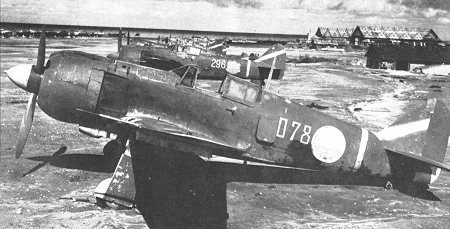 Otaki/Arii kits of this
vintage had nice recessed surface detail, but a minimal interior. However, they
were a definite improvement over the Revell and Monogram 1/48th scale
planes I had built as a younger kid. Markings are included for three aircraft.
The decals are somewhat glossy and the Hinomarus too bright, which is not
uncommon for kits of Japanese aircraft. I substituted faded Hinomaru from an
IPMS decal sheet. The rest of the kit markings were used.
Otaki/Arii kits of this
vintage had nice recessed surface detail, but a minimal interior. However, they
were a definite improvement over the Revell and Monogram 1/48th scale
planes I had built as a younger kid. Markings are included for three aircraft.
The decals are somewhat glossy and the Hinomarus too bright, which is not
uncommon for kits of Japanese aircraft. I substituted faded Hinomaru from an
IPMS decal sheet. The rest of the kit markings were used.
|
CONSTRUCTION |
This kit was built Out of the Box. Parts fit is okay in most areas. Some trimming is required at the wing/fuselage join. The most difficult piece to align is the forward section of the cowling. Flash was minimal.
|
PAINT & DECALS |
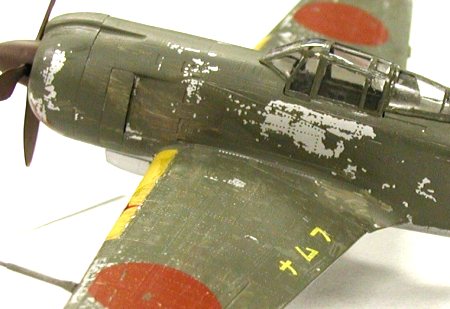 embly,
the kit was sprayed overall with Testor’s Model Master Metalizer 1451 Aluminum
Plate, followed by a cover of Dull coat to mute the shine. All control surfaces
were done in AeroMaster1098 IJA Gray/Green.
embly,
the kit was sprayed overall with Testor’s Model Master Metalizer 1451 Aluminum
Plate, followed by a cover of Dull coat to mute the shine. All control surfaces
were done in AeroMaster1098 IJA Gray/Green. 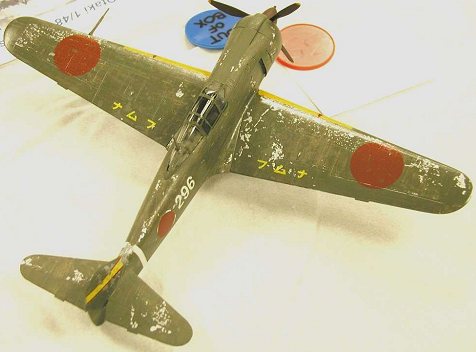 When the national markings
were applied, I tore them slightly after they had set to weather them as well.
Note that this aircraft had the white surround on the fuselage meatballs
partially painted over. Undersurfaces were left natural metal, since at this
stage of the war little time was wasted on painting
When the national markings
were applied, I tore them slightly after they had set to weather them as well.
Note that this aircraft had the white surround on the fuselage meatballs
partially painted over. Undersurfaces were left natural metal, since at this
stage of the war little time was wasted on painting|
CONCLUSIONS |
This works up into a nice kit. For the detail freaks, I recommend the Tamigawa offerings. For kit bashing or just a weekend slap-together, the Otaki kit is hard to beat, especially it can be found for as little as $5.00 at model shows. Lack of small parts and easy construction make this a fine kit for novices.
|
REFERENCES |
Japanese Aircraft Interiors 1940-1945 Robert Mikesh
Army Type 5 Fighter, FAOW no. 137
Maru Mechanic no. 45
Japanese Army Fighters, Pt.1 William Green & Gordon Swanborough
Copyright ModelingMadness.com. All rights reserved. No reproduction in part or in whole without express permission from the editor.
If you would like your product reviewed fairly and fairly quickly, please contact the editor or see other details in the Note to Contributors.
Back to Reviews Page 2023